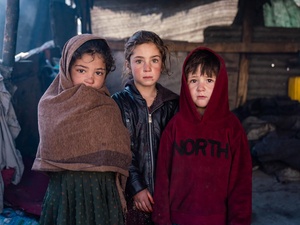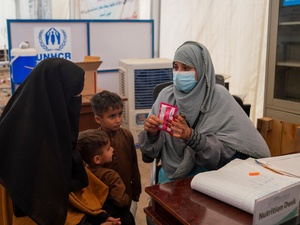Afghan returns cross 350,000 despite heavy rains
Afghan returns cross 350,000 despite heavy rains

The first IDPs leaving the Hesar Shahi camp near Jalalabad for their villages in Nangarhar province.
HERAT, Afghanistan, April 24 (UNHCR) - Heavy rains in parts of western Afghanistan failed to dampen the pace of repatriation to Afghanistan as the number of Afghans returning from surrounding states crossed 350,000 today.
Over 353,000 have gone home less than eight weeks after the UN refugee agency started assisted-repatriation programmes with neighbouring countries.
More than 327,000 Afghans have returned from Pakistan since March 1, and some 17,000 from Iran since April 9. Over 8,900 have been repatriated from Tajikistan, with 18 from Turkmenistan.
In western Afghanistan, heavy rains delayed some returns to Badgis province, but that has not stopped several thousand Afghans in Iran from approaching registration centres daily.
To ease the pressure on the Dogharoun/Islam Qala border crossing west of Herat, currently the sole entry point from Iran, a second official repatriation corridor further south at Miljak is planned to open shortly. This will happen once UNHCR is satisfied that security and stability have returned to Zaranj in Afghanistan's south-western Nimroz province.
With repatriation gaining momentum, UNHCR is also monitoring the situation in areas where coalition forces are conducting military operations. These include Paktia, Khost, Uruzgan and some parts of Paktika, principally those bordering Pakistan.
The return of internally displaced Afghans is also on track. Since Monday, more than 2,000, mostly ethnic Hazara, Afghans have started returning to the 13 villages in the Shaighan valley region after authorities cleared the area of land mines and unexploded ordnance. Up to 7,500 are expected to return under a joint UNHCR-IOM programme.
Another over 2,000 internally displaced persons (IDPs) have begun moving out of tents in Hesar Shahi back to villages in Nangarhar province. Returns to Laghman province have been put on hold due to continuing security concerns in the region.
Last week, the UN refugee agency concluded the repatriation of thousands of IDPs from the old Soviet compound in Kabul back to their villages in the Shomali plain. The last 2,697 IDPs returned home Thursday, bringing to 14,625 the total number of people who have been assisted in a programme launched by UNHCR, the Ministry of Repatriation and IOM in early March.
On the same day, 585 IDPs left the south-eastern frontier of Spin Boldak for Ghazni and Paktika provinces despite continuing reports of instability in parts of these provinces.
More than 3.7 million refugees have fled war- and drought-ravaged Afghanistan over the last two decades. Most of them live in Pakistan and Iran. Another 1.2 million Afghans were forced to flee their homes for safety elsewhere in the country. The UN refugee agency hopes to help 800,000 refugees return home this year, along with 400,000 IDPs.









